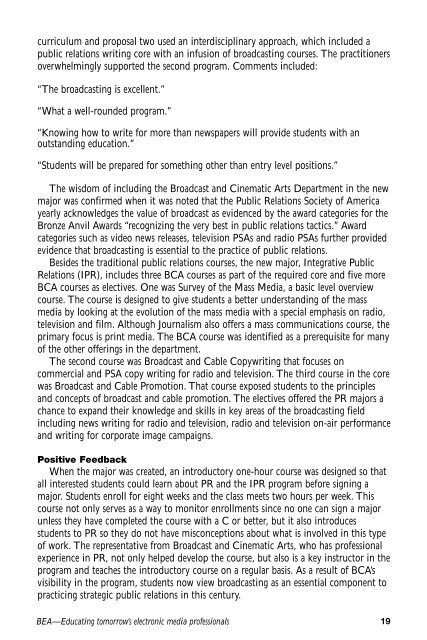Feedback May 2002 (Vol 43 No 2)
Feedback May 2002 (Vol. 43, No. 2) - Broadcast Education ...
Feedback May 2002 (Vol. 43, No. 2) - Broadcast Education ...
- No tags were found...
You also want an ePaper? Increase the reach of your titles
YUMPU automatically turns print PDFs into web optimized ePapers that Google loves.
curriculum and proposal two used an interdisciplinary approach, which included apublic relations writing core with an infusion of broadcasting courses. The practitionersoverwhelmingly supported the second program. Comments included:“The broadcasting is excellent.”“What a well-rounded program.”“Knowing how to write for more than newspapers will provide students with anoutstanding education.”“Students will be prepared for something other than entry level positions.”The wisdom of including the Broadcast and Cinematic Arts Department in the newmajor was confirmed when it was noted that the Public Relations Society of Americayearly acknowledges the value of broadcast as evidenced by the award categories for theBronze Anvil Awards “recognizing the very best in public relations tactics.” Awardcategories such as video news releases, television PSAs and radio PSAs further providedevidence that broadcasting is essential to the practice of public relations.Besides the traditional public relations courses, the new major, Integrative PublicRelations (IPR), includes three BCA courses as part of the required core and five moreBCA courses as electives. One was Survey of the Mass Media, a basic level overviewcourse. The course is designed to give students a better understanding of the massmedia by looking at the evolution of the mass media with a special emphasis on radio,television and film. Although Journalism also offers a mass communications course, theprimary focus is print media. The BCA course was identified as a prerequisite for manyof the other offerings in the department.The second course was Broadcast and Cable Copywriting that focuses oncommercial and PSA copy writing for radio and television. The third course in the corewas Broadcast and Cable Promotion. That course exposed students to the principlesand concepts of broadcast and cable promotion. The electives offered the PR majors achance to expand their knowledge and skills in key areas of the broadcasting fieldincluding news writing for radio and television, radio and television on-air performanceand writing for corporate image campaigns.Positive <strong>Feedback</strong>When the major was created, an introductory one-hour course was designed so thatall interested students could learn about PR and the IPR program before signing amajor. Students enroll for eight weeks and the class meets two hours per week. Thiscourse not only serves as a way to monitor enrollments since no one can sign a majorunless they have completed the course with a C or better, but it also introducesstudents to PR so they do not have misconceptions about what is involved in this typeof work. The representative from Broadcast and Cinematic Arts, who has professionalexperience in PR, not only helped develop the course, but also is a key instructor in theprogram and teaches the introductory course on a regular basis. As a result of BCA’svisibility in the program, students now view broadcasting as an essential component topracticing strategic public relations in this century.BEA—Educating tomorrow’s electronic media professionals19
















